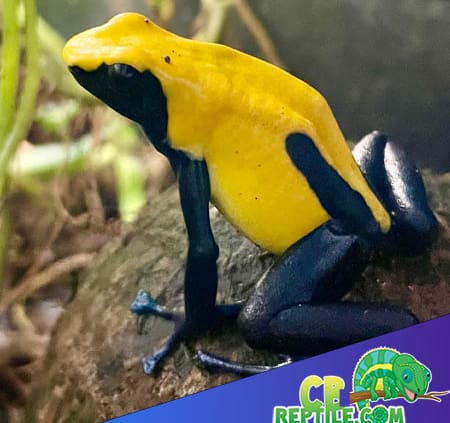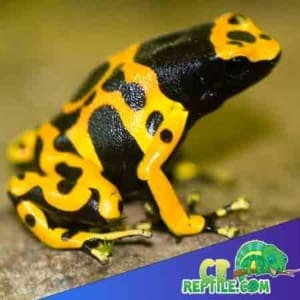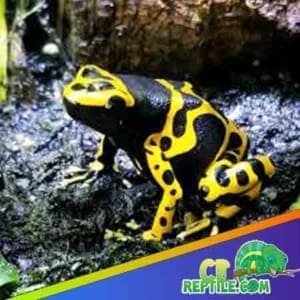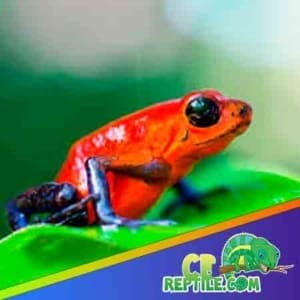

Captive-Bred Poison Frog Humidity & Temperature—With UVB, Fogger, Habitat & Care Tips
Achieving the right humidity and temperature is the single most important foundation in poison frog husbandry. These amphibians breathe and hydrate through delicate skin, so environmental control directly affects appetite, coloration, immune strength, and longevity. Below, you’ll find practical ranges, how to create stable gradients, where UVB fits, and how a fogger complements a planted, bioactive habitat. We’ll also touch on diet and supplementation to show how nutrition and climate work together.

Why Humidity & Temperature Matter So Much
Poison frogs come from humid forest understories where air is moist, temperatures are moderate, and moisture cycles throughout the day. In captivity, proper humidity supports skin function and hydration, while correct temperatures power digestion and activity without causing stress. When these parameters drift—air too dry, temperatures too high—frogs often hide, eat less, and become susceptible to opportunistic issues. Get this duo right and everything else becomes easier.
Target Ranges & Smart Gradients
- Day temperature: ~72–78°F (22–26°C)
- Night dip: ~2–6°F (1–3°C)
- Relative humidity: 70–100% with gentle daily cycling
- Photoperiod: 10–12 hours of light
- Digital thermometer with a probe at mid-height
- Reliable hygrometer (log daily highs/lows)
- Timers or a humidity controller for fogger/misters
- Plant-safe LED and low-output UVB fixture (see below)
Build microclimates: slightly drier, better-ventilated areas near the top and lusher, wetter pockets among dense foliage and leaf litter. A front-opening vivarium with a tight but ventilated lid helps you maintain humidity while keeping air fresh and oxygenated.
Humidity Strategy & Using a Fogger
Aim for consistently high humidity with subtle ebb and flow. After lights switch on, allow a mild drying period to stimulate activity; later in the day, restore moisture with misting or fogging. Manual misting (or an automated misting system) adds fine droplets to leaves and bromeliad cups for natural drinking. A cool-mist ultrasonic fogger can stabilize humidity and create a cloud-forest aesthetic, but it should run in short cycles on a timer or humidistat rather than all day.
- Best practices: Use RO or distilled water in foggers to prevent mineral deposits and clean reservoirs/tubing regularly to avoid biofilm.
- Placement: Direct the mist across foliage so it diffuses naturally; avoid blasting the same resting spot continuously.
- Ventilation: Pair humidity with airflow—small fans or cross-venting prevent stagnant, overly wet conditions.
Temperature Control Without Overheating

Most species thrive at moderate room temperatures. If your room runs warm, address the space rather than the enclosure: improved HVAC, shaded windows, or moving the tank away from electronics can lower peaks. Avoid hot dome fixtures over the vivarium, which trap heat and dry air. If needed, lightly increase ventilation at the top of the enclosure; moving air across the lid (not directly on the frogs) can shed heat while preserving humidity lower in the tank.
Seasonal tweaks are normal. Summer may call for shorter light periods and more frequent misting; winter may require humidifier support in the room. Always validate changes with your probes—guessing at climate is where most husbandry problems begin.
UVB: Small Dose, Big Benefit
Even though poison frogs live under canopy shade, gentle UVB can support natural vitamin D3 synthesis and overall vitality. Use a low-output UVB tube above the screen top and create shaded refuges so frogs can self-regulate exposure. Pair UVB with a plant-friendly LED to power photosynthesis; deliver a consistent 10–12 hour photoperiod on timers. If you elect not to use UVB, adjust supplementation (see below) to include dietary D3 more regularly.
Habitat & Tank Build That Stabilize Climate
A bioactive vivarium buffers humidity and reduces maintenance. Start with a drainage layer (LECA or a false bottom) beneath a mesh barrier, then add a moisture-retentive substrate such as an ABG-style blend. Top with generous leaf litter to shelter microfauna and keep amphibians comfortable. Hardscape—cork flats, branches, seed pods—creates hides, perches, and visual barriers that encourage bold, natural behavior.
Plant densely with pothos, philodendron, peperomia, ferns, and bromeliads. Living foliage moderates humidity swings and offers “leaf-cup” water points. A well-sealed, ventilated lid helps maintain moisture while cross-vent placement prevents stale air. Use dechlorinated, RO, or distilled water for misting and fogging to protect sensitive skin.
Diet, Calcium & Supplements—Working With Climate
Appetite and digestion follow temperature. In a properly warmed but not overheated tank, frogs eagerly hunt tiny moving prey. Offer a varied rotation—melanogaster and hydei fruit flies, springtails, pinhead/micro crickets, and occasional small roach nymphs—4–6 days per week in portions they finish within 15–30 minutes. Gut-load feeders with leafy greens and quality dry gut-load 24 hours before use to boost nutrition.
Dust most feedings with a calcium supplement and rotate a multivitamin once or twice weekly. If you provide UVB, use D3-free calcium for routine dustings and include a D3-containing product less frequently; without UVB, rely on a D3-inclusive schedule to support proper calcium metabolism. Remove uneaten insects after feeding windows and refresh bromeliad cups frequently to maintain water quality.
Daily & Weekly Routines
- Quick check of temperature and humidity readings
- Light misting or timed fogger cycle as needed
- Feed small portions; remove leftovers
- Visual health scan: posture, activity, breathing
- Log high/low climate data; adjust timers if seasonal shifts occur
- Prune plants to keep airflow, rinse leaves of excess supplement dust
- Top off/clean fogger reservoir and lines
- Boost microfauna cultures and refresh leaf litter as needed
Troubleshooting Signs
- Persistently dry glass/leaves: Increase misting frequency or fogger cycles; verify lid seal and add plant density.
- Condensation dripping constantly: Reduce fogger run-time and improve cross-ventilation to avoid stagnant air.
- Poor appetite or hiding: Check temperatures first, then humidity; confirm feeders are appropriately sized and gut-loaded.
- Mineral residue on glass: Switch to RO/distilled water and clean fogger components.
poison dart frogs for sale
and start with robust, well-started animals—then fine-tune climate and nutrition for long-term success.
Final word: stable humidity, moderate temperatures, and gentle UVB form the backbone of poison frog care. Layer in a bioactive habitat, disciplined fogger use, and a varied, supplemented micro-prey diet, and you’ll support vibrant color, strong appetites, and the natural behaviors that make these amphibians so captivating.
